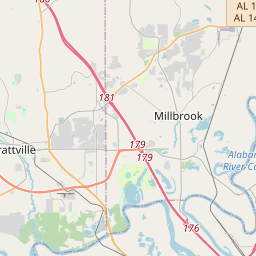Doster Road Artesian Well House
Historical marker location:
513 Doster Road, Prattville, Alabama
( Marker is at the intersection of Doster Road and Mobile Drive, on the right when traveling south on Doster Road.)
Marker installed: 2009







© OpenStreetMap contributors
More history nearby
The city of Mobile, Alabama is home to the oldest Mardi Gras celebration in the United States. The first Mardi Gras parade in Mobile took place in 1703, just one year after the city was founded by the French.
About Autauga County
Autauga County Timeline
Autauga County, located in central Alabama, has a rich and diverse history. The area was inhabited by Native American tribes for thousands of years before the arrival of European settlers. The region's first major European settlement was established in 1817 when Benjamin Fitzpatrick and his brother-in-law, William Wythe, built several cabins along the Autauga Creek. The county was named in honor of the Autauga Tribe, who once lived in the area.
During the early 19th century, Autauga County witnessed rapid growth and development. The arrival of the railroad in the 1830s led to increased agricultural production, particularly in cotton. The county quickly became a hub for cotton plantations, attracting settlers and enslaved African Americans who worked in the cotton fields. In 1860, Autauga County was one of the top cotton-producing counties in Alabama.
The Civil War had a profound impact on Autauga County, as it did on the rest of the South. Many men from the county enlisted in the Confederate Army, with some joining famous units like the 20th Alabama Infantry Regiment. The war resulted in significant loss of life and property damage, disrupting the region's socio-economic fabric.
After the war, Autauga County faced the challenges of Reconstruction. The county's economy gradually shifted from agriculture to industry, with the establishment of mills and factories. The arrival of the timber industry in the late 19th century also contributed to the county's economic growth. However, it wasn't until the 20th century that Autauga County experienced significant industrial and population growth. Today, it is a thriving county with a blend of historical charm and modern amenities.
During the early 19th century, Autauga County witnessed rapid growth and development. The arrival of the railroad in the 1830s led to increased agricultural production, particularly in cotton. The county quickly became a hub for cotton plantations, attracting settlers and enslaved African Americans who worked in the cotton fields. In 1860, Autauga County was one of the top cotton-producing counties in Alabama.
The Civil War had a profound impact on Autauga County, as it did on the rest of the South. Many men from the county enlisted in the Confederate Army, with some joining famous units like the 20th Alabama Infantry Regiment. The war resulted in significant loss of life and property damage, disrupting the region's socio-economic fabric.
After the war, Autauga County faced the challenges of Reconstruction. The county's economy gradually shifted from agriculture to industry, with the establishment of mills and factories. The arrival of the timber industry in the late 19th century also contributed to the county's economic growth. However, it wasn't until the 20th century that Autauga County experienced significant industrial and population growth. Today, it is a thriving county with a blend of historical charm and modern amenities.
Autauga County Timeline
This timeline provides a condensed summary of the historical journey of Autauga County, Alabama.
- 1818: Autauga County was established on November 21, 1818, as a county in the Alabama Territory.
- 1820: The county seat was established in the town of Washington.
- 1830: Autauga County experienced significant population growth with an increase in cotton production.
- 1861-1865: Autauga County residents participated in the American Civil War, with many serving in the Confederate Army.
- 1866: The county seat was moved to Prattville, which became a thriving industrial town.
- 1930s: Autauga County faced economic challenges during the Great Depression.
- 1950s-1960s: The Civil Rights Movement brought significant changes and challenges to Autauga County.
- 1970s-1990s: The county experienced steady growth and development in various sectors, including industry and education.
- 2000s: Autauga County continued to grow as a commuter community for nearby Montgomery.